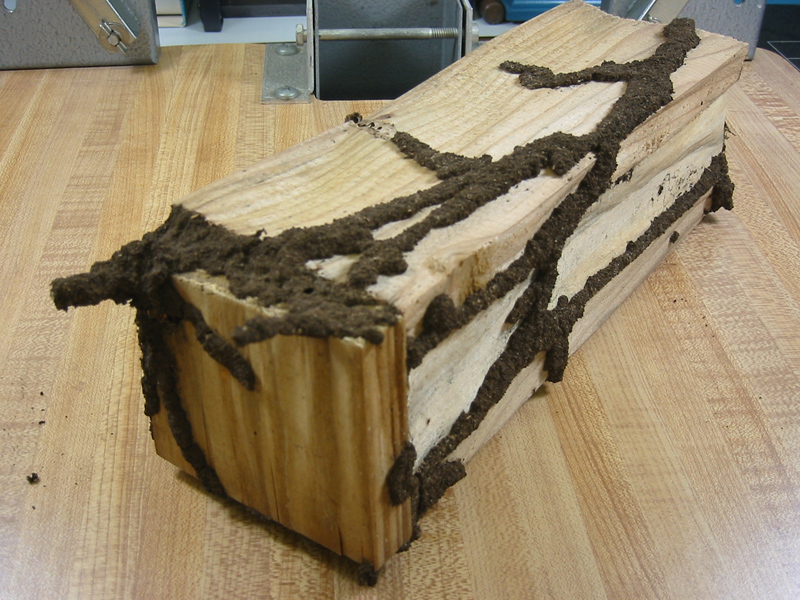For the Public - About Termites
Termites are highly social insects with one of the most sophisticated family structures in the animal kingdom. There are approximately 2,700 species of termites found worldwide. Hawaii has 8 species of termites, all non-native introductions through human transport of infested wood materials.
All Termites
- Are social insects (have overlapping generations, reproductive division of labor, and brood care)
- Have different family members with different colony roles
- Consume wood along with other plant material containing cellulose (main component in plant cell walls)
- Prefer to live in the dark
- Need food, water, and shelter in order to survive
In natural areas, termites are essential organisms in the environment. Termites decompose cellulose, the main component of plant cell walls and recycle nutrients back into the soil for use by other living organisms. Termites are also an important food source for many amphibians, reptiles and birds. Unfortunately, termites receive a bad reputation because they are unable to distinguish between the dead wood in the forest and the dead wood used in our homes.
The Formosan subterranean termite
The Formosan subterranean termite, Coptotermes formosanus Shiraki, locally known as simply the ground termite, is the single most damaging insect pest to homes and other structures in Hawaii. In 1990, annual figures for prevention, control, and repair were conservatively estimated at $60 million. By 1996, that figure had grown to over $100 million per year.
Poorly planned or constructed homes built on large existing colonies can be serverely damaged in as little as two years. Colony sizes for this termite range from 2 to 10 million individuals. Damage by this insect is especially insidious since much of it occurs quietly, unnoticed. Often, by the time evidence of an infestation is discovered, costly damage has already taken place.
A somewhat famous example of a termite problem gone out of control is the old Honolulu Stadium, known affectionately as the "Termite Palace." The stadium was found to be severely termite-damaged when it was torn down in 1976 to make way for the larger, all-steel Aloha Stadium. A park now marks the site where the old wooden stadium once stood.
- Scientific name: Coptotermes formosanus
- Place of origin: East Asia
- Body: segmented, 3 body parts
- Length: 2-3 mm
- Hair: none
- Eyes: blind
- Color: pale white
- Food: cellulose, plant material
- Shelter: underground, in the soil
- Life style: social insects
- Colony size: 2-10 million
Where do they live?
Subterranean termites live in the ground, unlike drywood termites which living inside the wood they eat. The ground provides the moisture needed by the subterranean termites. When they find a food source above ground they build a safe pathway or “mud tube” to create a connection from their home to the food.
What do they eat?
Termites feed on cellulose found in wood, paper, cardboard and other plant material.
How do they eat wood?
Termites are unable to digest cellulose on their own so they have friendly inhabitants helping them. There are symbiotic protozoa or microorganisms found inside the termite gut that help termites digest cellulose.
What are social insects?
Social insects develop organized society where individuals perform tasks to help each other and live together within a colony. There are different forms or castes members that have different duties and responsibilities within a colony.
What are the castes?
- Reproductives: King and queen are responsible for laying eggs. They are the parents of the entire colony.
- Soldiers: Protector of the colony. They have large mouthparts that allow them to fight but they are unable to feed themselves.
- Workers: Responsible for building tunnels and nests. They also tend to the eggs and young. They’re primary duty is to feed all the other termites within the colony.
- Alates: Winged termites that swarm primarily during the summer months. These termites leave the colony, form a pair, find a suitable shelter, drop there wings and establish their own new colony. Their primary purpose is dispersal.
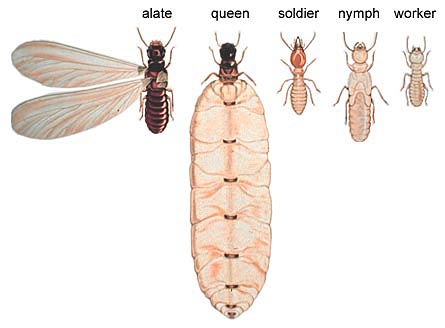
Swarming
A familiar sight to many Hawaii residents is the annual termite swarms. Swarming season is in May and June, but small swarms may occur at any time. Swarms only occur on warm, humid, nearly windless nights, and last about half an hour.
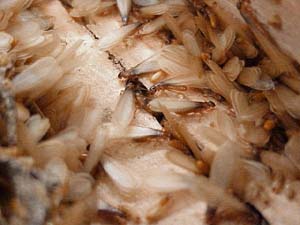
The swarmers, or alates, as they are technically known, embark on their journey from holes called flight slits. They are attracted to the nearest light source, usually a street light or house lights.
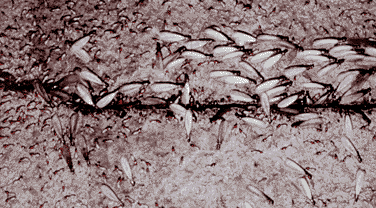
After a short flight, the alates drop to the ground and shed their wings. The males seek out the females and follow them in tandem. The happy couples then search for a suitable niche to provide shelter while they mate. Most of the alates die before they ever mate--they get eaten by spiders, geckos, chameleons, toads, ants, or other predators. Or, they are unable to satisfy the three requirements needed in order to mate successfully: food, water, and shelter.
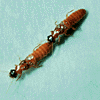
Mating Chamber
The female lays her first batch of 15-25 eggs about five days after mating. The eggs hatch in 21-30 days later. It is then that the mating chamber becomes known as the nursery or royal chamber. The male and female are now bestowed the royal titles of king and queen.
After two molts, the young begin to forage for food away from the nest. It is then that they become known as workers.
The queen lays another batch of eggs. These and all subsequent offspring are fed by the workers. This process repeats until the colony reaches a population of 2 million or more. It can take several years to reach such a size.
The Queen
Over a period of a few years, the queen grows into a monstrous termite, over 100 times her original weight. She is about 1 to 1.25 inches long. Her large abdomen is due to the growth of her ovaries, which produce about 2,000 eggs per day. Undisturbed, the queen will live in the royal chamber for the rest of her life. She is so big that she can't easily move on her own--she must be moved, fed, and groomed by the workers.
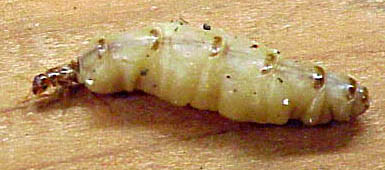
Drywood Termites
The drywood termite has two castes: soldier and reproductive. "Workers" of drywood termites are also called "false workers" unlike "true workers" of subterranean termites because they are immature termites that eventually become soldiers or reproductives. Immature drywood termites perform the same role as true workers (feeding/grooming/queen care/etc.), but will all either become a soldier or a reproductive drywood termite when they mature.
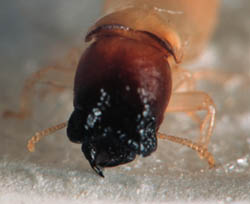
Visit the UH Termite Project page for more information on termites

